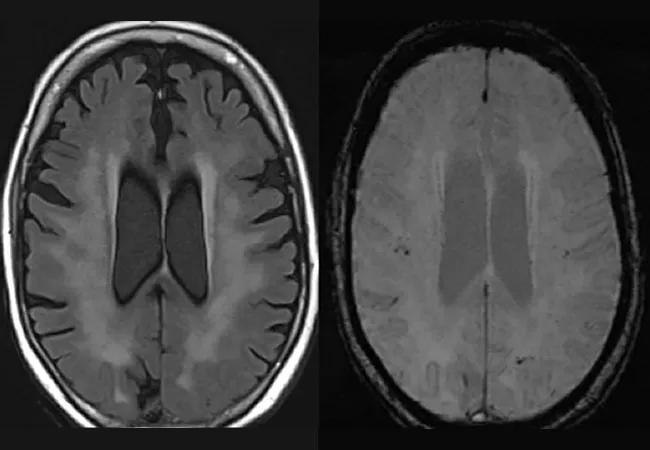Comparative MRI study suggests unique pathophysiology in COVID-19 context

Acute respiratory distress syndrome (ARDS) is a common complication of COVID-19, and cerebrovascular and neurologic complications have been reported with severe COVID-19 infection. Whether patterns of cerebrovascular injury are related to COVID-19 or may be manifestations of ARDS and ICU treatment, however, is an open question.
Advertisement
Cleveland Clinic is a non-profit academic medical center. Advertising on our site helps support our mission. We do not endorse non-Cleveland Clinic products or services. Policy
To shed light on the issue, Cleveland Clinic researchers performed a first-of-kind study comparing brain MRI findings in patients with COVID-19 ARDS versus non-COVID-19 ARDS. The results, which hint at unique pathophysiology in COVID-19, were presented at the International Stroke Conference 2022 last month.
“Other case series have been published of brain imaging in patients with COVID-19, but ours is the first to try to tease out whether the changes seen are related to the infection,” says senior author Ken Uchino, MD, a stroke neurologist and Head of Research and Education in Cleveland Clinic’s Cerebrovascular Center. “We found that microbleeds were more common than expected among our patients with ARDS who had brain MRIs, but the mechanism of injury is unknown.”
The retrospective case-control study included 26 patients with COVID-19 ARDS and 66 patients with non-COVID-19 ARDS, all of whom had an MRI during their index hospitalization. Both groups were selected from the Cleveland Clinic health system registry, with admission dates from March 2020 to July 2021 for the ARDS patients with COVID-19 and from 2010 to 2018 for those without COVID-19.
Dr. Uchino notes that the registry contained data on more COVID-19 patients with ARDS but only about 10% of them underwent MRI. “This subset was small because many patients with this condition are so unstable that it’s not safe to take them out of the ICU for testing,” he explains. “This is a challenge for others as well, which is why previous case reports have been so limited.”
Advertisement
Patients in the COVID-19 and non-COVID-19 ARDS groups were matched 1:1 by age and sex. The median age of the COVID-19 ARDS patients was 66, and 59% of them were male. Severity of ARDS and Glasgow Coma Scale scores were similar between the groups.
The Berlin definition was used to determine ARDS diagnosis. Cerebrovascular injury was classified as either cerebral ischemia (ischemic infarct or hypoxic ischemic brain injury) or intracranial hemorrhage, with the latter including intraparenchymal hemorrhage, subarachnoid hemorrhage, subdural hematoma and cerebral microbleeds.
After matching to control for age and sex, comparison of MRIs between ARDS patients with and without COVID-19 revealed a high frequency of cerebrovascular injury in both groups but no significant differences between groups in rates of cerebrovascular injury overall, cerebral ischemia, intracranial hemorrhage or cerebral microbleeds. Among the matched patients, cerebral microbleeds were seen in about half of patients in both groups (52% of those with COVID-19 and 41% of those without COVID-19). Ischemic injury was also common, seen in 35% of patients with COVID-19 and 43% of patients without COVID-19.
In contrast to those similarities between groups, two unique patterns of injury were seen only in the COVID-19 patients: hemorrhagic leukoencephalitis (3 patients; 12%) and bilateral cerebral peduncular ischemia with microhemorrhage (2 patients; 8%).

MRIs of the brains of two patients with COVID-19 ARDS demonstrating extensive white matter abnormalities (A, C) with underlying cerebral microbleeds (B, D).
Advertisement
“It’s notable that the prevalence of microbleeds was about 40% to 50% in both groups, which is higher than we would have expected, given the age of the patients,” observes Dr. Uchino. “What we don’t know is whether, in the patients with COVID-19, the injuries are directly related to the infection.”
“The high prevalence of cerebrovascular injury identified on imaging in ARDS patients both with and without COVID-19 suggests clinical underrecognition of neurologic complications of ARDS, and this may contribute to the prolonged neurologic recovery seen in severe ARDS regardless of the context,” says the study’s first author, Aaron Shoskes, DO, a neurology resident at Cleveland Clinic.
The next step in the research, according to Dr. Uchino, is a two-institution case series of autopsies on patients with COVID-19 and ARDS to explore what underlies the cerebral microbleeds. “There’s a need for further study of the vascular changes that occur in patients with ARDS and with COVID-19 so that we can understand the mechanisms that lead to brain injury and then try to identify treatments to prevent it,” he says.
Dr. Shoskes adds that the hemorrhagic leukoencephalopathic imaging pattern observed exclusively in several of the patients with COVID-19 has been described in prior reports of patients with COVID-19 characterized by extensive white matter changes with underlying hemorrhage or small bleeds. “Further research into the mechanism of the diffuse white matter injury and hemorrhage in COVID/COVID-ARDS is necessary,” he concludes.
Advertisement
Advertisement

Patients report improved sense of smell and taste

Clinicians who are accustomed to uncertainty can do well by patients

Unique skin changes can occur after infection or vaccine

Cleveland Clinic analysis suggests that obtaining care for the virus might reveal a previously undiagnosed condition

As the pandemic evolves, rheumatologists must continue to be mindful of most vulnerable patients

Early results suggest positive outcomes from COVID-19 PrEP treatment

Could the virus have caused the condition or triggered previously undiagnosed disease?

Five categories of cutaneous abnormalities are associated with COVID-19